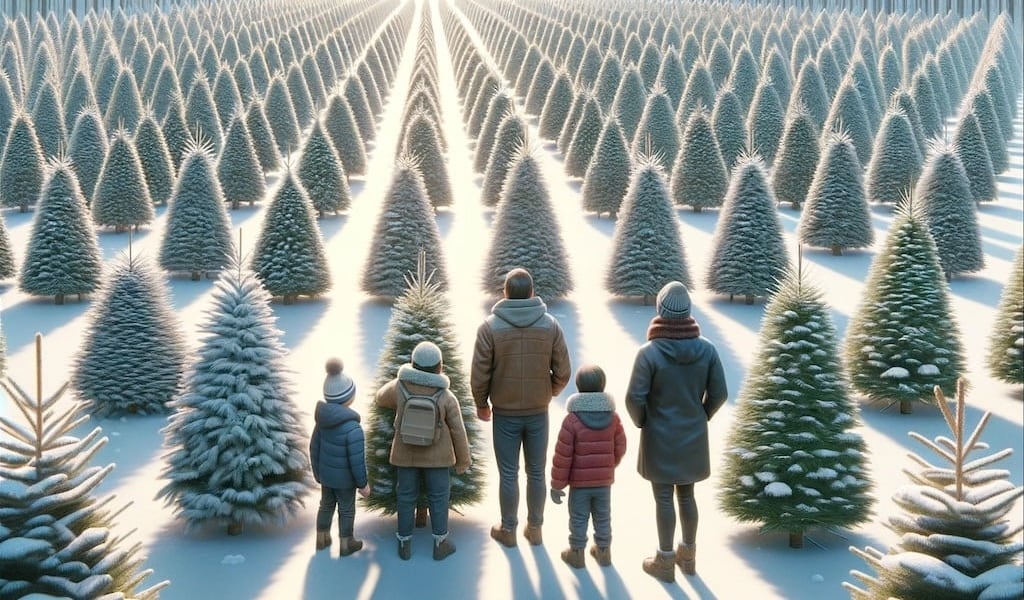With Black Friday behind us, the thoughts for some turn fully to Christmas. It’s a good three weeks since the first Christmas Ads aired, the usual roster of smile or tear-inducing big budget Christmas Ads have been fan-fared. John Lewis embrace new traditions, Aldi’s Kevin the Carrot explores a chocolate factory, Sainsburys and Rick Astley prove that time can stand-still, and TESCO help a teenager rediscover the lost magic of Christmas in an ad that rivals Oppenheimer for duration.
This weekend will see many of the country’s high streets illuminated, many families putting up a tree, and boxes of Heroes flying off the shelves. But in times of increasing concern for the planet, is it better to go “natural” each year, buy a rooted tree, or invest in a tree that will last for years? The answer it seems is not straightforward. We take a light-hearted look at a serious subject.
The occasion
Ah, the enchantment of Christmas! It’s not just about the gifts and the glittering lights, but also about those cherished moments and sensory delights that come with the festive season. Let’s sprinkle a little more yuletide magic on our tree tale, shall we?
Imagine the crisp, wintry air as families in the UK embark on their annual pilgrimage to choose the perfect Christmas tree. For many, this tradition is the true start of the season’s festivities. Amidst the laughter and muffled chatter, wrapped in scarves and gloves, they wander through rows of trees, each one a potential centre-piece of their celebrations.

Real or cut trees
The allure of a real tree is undeniable. Its fresh pine scent fills the home, evoking memories of Christmases past and promising new joys. Each of the seven million trees bought annually in the UK, with their lush green needles and unique character, brings a piece of the winter forest into the home.
And let’s not forget the environmental dance – while these trees grow for 10-12 years, they are guardians of wildlife, capturing carbon and spreading holiday cheer in their own silent way.
Choosing a local source minimises CO2 associated with collecting it, and if you can buy one that’s not wrapped in nylon, your tree will get more green points.
Once they have served their purpose, environmentally sensitive disposal is important. The Independent lists a variety of ways to dispose of your tree in an eco-friendly way.
Artificial trees
But what of the artificial trees, twinkling in many a window? Their journey is different but not without its own sparkle. These trees, hailing from faraway lands, are marvels of convenience and longevity. The glittering lights and tinsel adorn branches that have seen many a Christmas, holding memories in their boughs.
Yes, their carbon footprint is heavier, at around 40kg for a two-metre tree, and it takes a commitment of ten festive seasons to balance the scales of their environmental impact. But for those who embrace this choice, these trees become part of the family’s Christmas fabric, unwrapped each year like a beloved heirloom.

Rooted trees
And then, there’s the rooted tree, a symbol of sustainability and a growing Christmas tradition. These trees offer a unique opportunity to extend the festive joy beyond December. They’re not just decorations but living, breathing companions that can be replanted, reducing their carbon footprint dramatically.
Imagine a Christmas tree that grows with your family, witnessing the changing years, an evergreen emblem of your commitment to the planet. A real, rooted tree is the pinnacle of eco-friendly celebrations, but getting a tree from a chilly garden to a centrally-heated home, and back again to a frosty garden requires some green-fingered care.
Decorations
The tree is part of the environmental conundrum, and the items that adorn it are also key. Decorations that are made from sustainable materials will up your eco festive game, as will decs that are re-used from one year to the next. The mantra of reduce and reuse should be close in mind.
Wrap-up
With our serious head on, the most environmentally kind thing to do is to mark the occasion in a way that does not place an additional environmental burden on an already stressed planet. There are ways to create a centrepiece in a home that don’t consume precious resources, or contribute to landfill. There’s also a cost of living crisis, and not all households can afford the additional expense that this time of year can bring. With this in mind The Times provides a number of practical tips to reduce the cost of Christmas.
Christmas can be a time when there’s more waste and so with this in mind, we have a list of 21 eco apps that will help you to reduce, reuse, and recycle more.
In the end, whether it’s the earthy aroma of a fresh pine, the familiar ease of an artificial tree, or the sustainable promise of a rooted one, each choice is wrapped in its own magic. The key is to select not just with the heart but also with a mind for our environment. After all, the greatest gift we can give future generations is a world as enchanting as our Christmases today. 🌟🎄